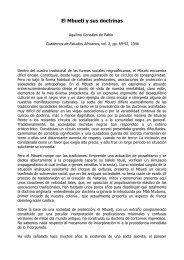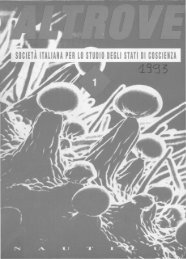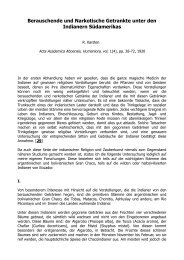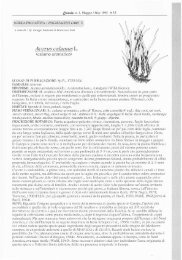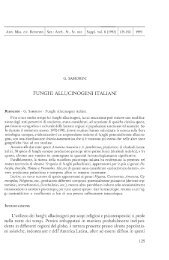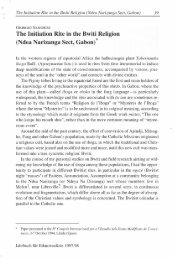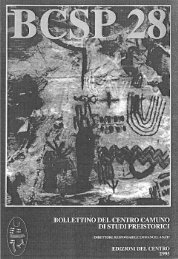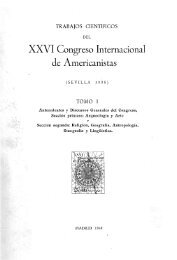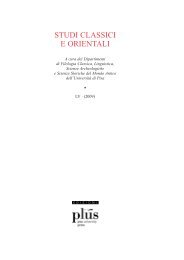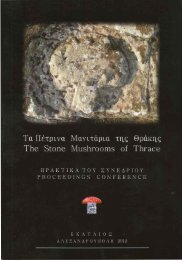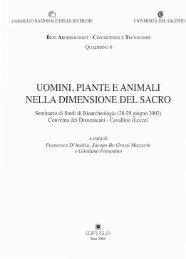Gli "alberi-fungo" nell'arte cristiana - Giorgio Samorini Network
Gli "alberi-fungo" nell'arte cristiana - Giorgio Samorini Network
Gli "alberi-fungo" nell'arte cristiana - Giorgio Samorini Network
Create successful ePaper yourself
Turn your PDF publications into a flip-book with our unique Google optimized e-Paper software.
107<br />
GIORGIO SAMORINI Eleusis, n.s., n. 1, 1998<br />
li.<br />
Quindi, nei funghi del mosaico di Aquileia non<br />
appaiono rappresentati in maniera esplicita né l'agarico<br />
muscario né l'ovulo buono. Per quest'ultimo, tra l'altro,<br />
non si sarebbe presentata alcuna necessità di rappresentarlo<br />
in una maniera "nascosta" per i profani, come nel caso dell'agarico<br />
muscario. Restano aperte le possibilità che si<br />
intendesse rappresentare una specie di fungo differente<br />
dalle due precedenti o più semplicemente un "fungo" aspecifico.<br />
E' stata avanzata l'ipotesi che nel mosaico siano<br />
stati rappresentati i cibi - fra cui dei funghi - che venivano<br />
consumati dai fedeli nel corso delle agapi, i misteriosi pasti<br />
rituali in costume presso le prime comunità cristiane<br />
(BRUSIN & ZOVATTO 1957, cit.in FABBRO 1996).<br />
I fully appreciate just how complex an investigation<br />
of this kind is, how many pitfalls await the researcher, and<br />
how easily he may be "Ied up the garden path". I therefore<br />
prefer not to offer my own interpretations of the various<br />
works of art presented here.<br />
In any case, we may confidently conclude from what<br />
has emerged that justifications do exist for serious and<br />
unprejuduced ethnomycological study of early Christian<br />
culture, and it is our hope that such studies will take piace.<br />
Comprendo la complessità di questa indagine e il<br />
rischio concreto di incorrere in travisazioni o in conclusioni<br />
superficiali. Per questo motivo preferisco astenermi dall'offrire<br />
interpretazioni a ciò che è finora emerso dall'esame<br />
dei documenti.<br />
L'unica cosa che ritengo di poter affermare con un .<br />
certo grado di sicurezza è che ciò che è sinora emerso dall'esame<br />
di questi documenti è sufficiente per giustificare e<br />
promuovere un'indagine etnomicologica seria e priva di<br />
pregiudizi della cultura <strong>cristiana</strong> antica.<br />
Ringraziamenti / Acknowledgements - Desidero ringraziare per le utili indicazioni e discussioni riguardo alcuni dei documenti presentati in<br />
questo articolo / - l wish lO Ihank Ihe following for Ihe aid and suggestions regarding Ihe material presenled in this arlicle: prof. Elemire<br />
Zolla (Montepulciano, SI, Italy); Francesco Festi (Museo Civico di Rovereto, TN, Italy); Dona & Manuel Torres (Florida International<br />
University, Miami, FL, USA); Dr. Guido Baldelli (Monzuno, BO, Italy); lonathan Ott (Natural Products, Xalapa, Vér., Mexico); losep M.<br />
Fericgla (Institut de Prospectiva Antropologica, Barcelona, Spain); Tjakko Stijve (Nestlé Research Centre, Lausanne, Switzerland); lochen<br />
Gartz (University of Leipzig, Germany).<br />
Bibliografia / References<br />
ARIETTI NINO & RENATO TOMASI, 1975, l funghi velenosi, Edagricole, Bologna. <br />
BECKER G., 1989, Setas, Susaeta, Madrid. <br />
BENNETT CHRIS, LYNN OSBURN & JUDY OSBURN, 1995, Green Gold the Tree ofLife. Marijuana in Magic and Religion, Access <br />
Unlimited, Frazier Park, CA.<br />
CALVETTI ANSELMO, 1986, Fungo Agarico muscario e cappuccio rosso, Lares, 52:555-565.<br />
CANESTRINI DUCCIO, 1985, La salamandra, Rizzoli, Milano.<br />
CHARBONNEAU-LASSAY LOUIS, 1994 (19.), Il Bestiario del Cristo, 2 volI., Arkeios. Roma.<br />
CHARBONNEAU-LASSAY LOUIS, 1997, Le Pietre Misteriose del Cristo, Arkeios, Roma.<br />
COOK ROGER , 1987, L'Albero della Vita, RED, Como.<br />
FABBRO FRANCO, 1996, Did Early Christian used Hallucinogenic Mushrooms? Archaeological evidence, on web:<br />
www.etnoteam.itlmaiocchi.<br />
FANTAR H. M'HAMED (Ed.), 1995, l mosaici romanici di Tunisia, Jaca Book, Milano.<br />
FERICGLA M. JOSEP, 1993, Las supervivencias culturales y el consumo actual de Amanita muscaria en Catalufia,<br />
Ann.Mus. Civ.Rovereto, Suppl. voI. 8:245-256.<br />
FERICGLA M. JOSEP, 1994, El Hongo y la génesis de Las culturas, Los Libros de la Liebre de Marzo, Barcelona (originally



